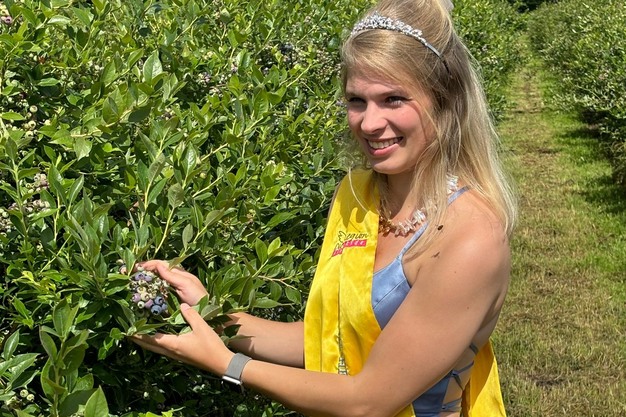This year's blueberry season opening took place yesterday, Wednesday 19 June 2024, at the Rodemeier family's blueberry farm in Walsrode. Reigning blueberry queen Tessa I. officially opened the season. Following the start of the blueberry harvest in southern and central Germany, the open field blueberry season is now also beginning in Germany's largest blueberry-growing region: the North German Plain. Lower Saxony is the centre of German blueberry cultivation, with around 2,200 hectares (ha) under cultivation and around 65 percent of production.
In Germany, 458 farms grow blueberries on 3,469.12 hectares. The harvest volume in 2023 was 15,322 tonnes, almost the same as in 2022. 76 farms in Germany were completely organic in 2023, with a total harvest volume of 423.51 tonnes. (Source: Federal Statistical Office)
If the weather remains moderate, the main open field harvest will take place between late June and late July this year. Blueberries are already being harvested from protected foil tunnels and the first early open field varieties are being harvested. The harvest of the Duke early main variety will pick up speed from week 25. The berry cultivation experts at the Lower Saxony Chamber of Agriculture (LWK) are expecting good fruit quality and good yields.
 © Vereinigung der Spargel- und Beerenanbauer e.V.
© Vereinigung der Spargel- und Beerenanbauer e.V.
Reigning blueberry queen Tessa I.
Ideal growing conditions
"Here in Lower Saxony, most blueberries experience ideal growing conditions because they grow on heathland or moorland, their natural habitats," reported Felix Koschnick, head of the LWK's soft fruit research station in Vechta-Langförden.
In addition to the location, the weather is also very important for successful cultivation, Koschnick emphasised. The water supply to the plants and soil this winter and spring, as well as moderate temperatures, "optimistically allow us to expect a good total yield for 2024, with great quality," said the head of the LWK soft fruit trial station.
Last year, 156 farms in Lower Saxony (2022: 153 farms) harvested a total of 9,923 tonnes (2022: 9,457 tonnes) of cultivated blueberries, according to the State Statistical Office. According to the current forecast, consumers will have sufficient blueberries from Lower Saxony available this summer: in fields for self-picking, in direct marketing and in food retail. Thanks to a combination of varieties with different ripening dates, the blueberry season in Lower Saxony will last until September.
Brandenburg: Late frost leads to losses of up to 50 per cent
The harvest is now also getting underway in Brandenburg. Around 24 farms are growing cultivated blueberries on around 419 hectares. This means that the area under cultivation has increased by 17 hectares compared to 2022. Blueberries thus remain Brandenburg's most important shrub berry species. In 2023, the harvest volume was 1,552 tonnes of cultivated blueberries, which corresponded to around two thirds of the total harvest volume of all shrub berries. Due to their popularity and steadily increasing demand, the cultivation area has increased continuously over the last 10 years: from 107 hectares (2013) and 331 hectares (2018) to a record cultivation area of around 419 hectares in 2023. The district of Potsdam-Mittelmark is the leader in cultivation with around 346 hectares.
"Increasing temperatures, dry spells and extreme weather events such as frost and hail have caused a massive increase in damage to horticulture," explains Horticulture President Dr Klaus Henschel. The cold snap in the second half of April, with night-time temperatures of -3 to -7°C, caused serious damage to various crops in Brandenburg. The damage to apples, chokeberries and cherries was up to 100% in some cases, while the damage to blueberries is expected to be between 30 and 50%, depending on the location. The few areas in Brandenburg with frost protection, on the other hand, survived the frosts relatively well.
For more information:
www.spargelundbeerenanbauer.de
www.gartenbau-bb.de
